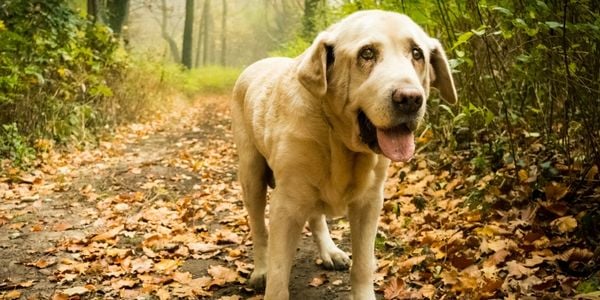 The word paralysis often induces fear in many dog owners, and it is understandable.
The word paralysis often induces fear in many dog owners, and it is understandable.
When paralysis is brought up in conversation, most people justifiably assume that it's the inability to use one's legs.
However, paralysis actually means the inability to make voluntary muscle movements. And, when paralysis is partnered with the word laryngeal, referring to the area in an animal's throat known as the larynx, we get a condition known as Laryngeal Paralysis.
But, of course, this still sounds terrifying! Understandably. So what exactly is laryngeal paralysis in dogs?
Can you prevent laryngeal paralysis? Unfortunately, the short answer is no. However, you can manage symptoms to prevent your dog's symptoms from worsening.
Skip to section:
What Is Laryngeal Paralysis?
Firstly, let’s talk anatomy. The larynx is the upper portion of an animal's throat containing the vocal cords. It is also responsible for assisting with swallowing and passing air into the trachea (‘the breathing tube’). Additionally, it prevents objects such as food, water, and other foreign material (dirt, bits of chew toys, etc.) from accidentally entering into the trachea instead of the esophagus (the ‘swallowing tube’) as they basically sit on top of one another. So, it is a very important structure made up of cartilage and muscle with very important roles to play!
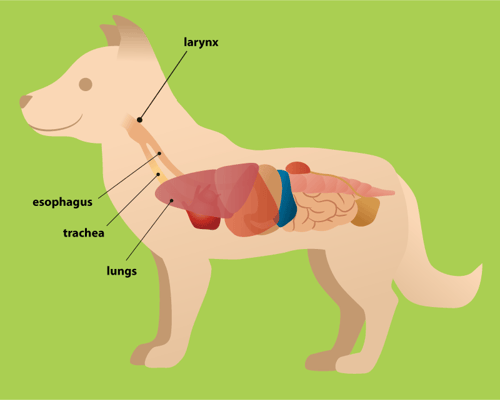
In normal canine anatomy, the larynx has two pieces of cartilage on either side known as the arytenoid cartilages (arytenoids), which automatically move inward to cover and protect the airway (trachea) when swallowing, protecting it from foreign material entering. They then open when inhaling to allow the maximum amount of air into the trachea and, subsequently, the lungs.
In this respect, these two pieces of cartilage function similarly to french doors, actively opening (abducting) when the dog breathes in and actively closing (adducting) during swallowing.
In cases of laryngeal paralysis, one or both of the arytenoids fails to open fully during the breathing-in phase of respiration. This is because the muscle responsible for the function of the arytenoid cartilage (the cricoarytenoideus dorsalis muscle) has become paralyzed due to dysfunction of the laryngeal nerve that "stimulates" it.
So, the cartilage stays in place when a dog is breathing, and as such, they now have a much more narrow opening through which they can breathe, which, as you might suspect, is a serious problem.
If you close your hand into a gentle fist (no nail digging!) and put it against your mouth and try breathing in and out a few times — this is what it feels like all the time for these dogs. Panic-inducing, right? So no wonder our canine friends become distressed and anxious.
When this paralysis occurs to both arytenoids, the seriousness is doubled. The gap in which the air can flow through to the trachea has dramatically decreased again. Your dog will now likely experience some form of respiratory distress in their lifetime, which will likely result in a trip to the Animal ER.
We will share activities below to avoid to help minimize this risk, but you should be aware so that you can keep an eye on any changes in your dog's breathing and behavior.
What Causes Laryngeal Paralysis?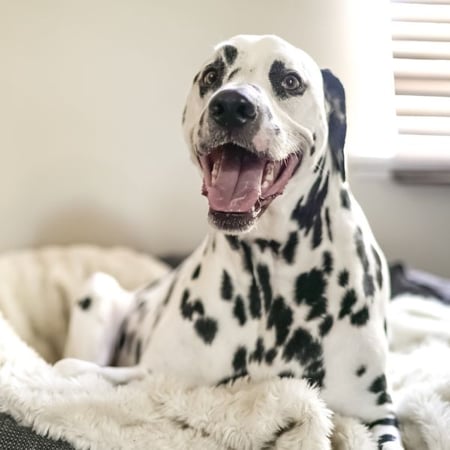
Laryngeal Paralysis, commonly referred to as ‘LarPar,’ can either be congenital (dogs born with the problem) or it is acquired and develops over time.
Congenital Laryngeal Paralysis
The congenital form of LarPar is much less common and typically occurs in specific breeds, including Siberian Huskies, Dalmatians, Bulldogs, and Bouvier des Flandres.
The condition typically presents when these dogs are still puppies, at around two to six months old. The affected puppies may gag frequently, they can have difficulty breathing or swallowing, and they may have an abnormal-sounding bark.
In Dalmatians, in particular, this condition is part of another form called laryngeal paralysis-polyneuropathy complex, and it is recommended they are not used for breeding.
Acquired Laryngeal Paralysis
The acquired form of LarPar was often considered to have an unknown cause, or in veterinary speak, it was termed ‘idiopathic’ (meaning no known cause) and, as such, was referred to as ‘Idiopathic Larygeal Paralysis’ or ILP.
However, in more recent years (2005-2013), studies at the Universities of Michigan and Tennessee revealed that LarPar might be part of a more complex series of neurological dysfunctions in older dogs rather than just a single entity that is limited to just the dysfunction of the laryngeal nerves.
As a result, many veterinarians researching this newer collection of polyneuropathies (definition: dysfunction of multiple nerves of the body) proposed a name change from ILP or idiopathic laryngeal paralysis to a more appropriate name of ‘geriatric onset laryngeal paralysis polyneuropathy’ (GOLPP).
As I mentioned, in some circumstances, this condition can be life-threatening.
I know this may sound scary, giving your pup more problems. However, having a cause for your dog's problem, rather than not knowing the ‘why,’ is much better than not having one. Research will only continue to provide more information and answers, and hopefully, a diagnosis and prevention!
Laryngeal Paralysis and Breeds
As mentioned above in the Congenital section, some breeds can be born with this condition.
Additionally, there has been some correlation between this condition developing in specific breeds, particularly large-breed senior dogs. And it should be noted that "senior" refers to any large breed around the age of 10 years, depending on their weight. The bigger the dog (not heavier/more obese, but larger in stature, i.e., a Great Dane vs. a Labrador), the earlier in their life they become a senior (geriatric).
The most common breeds that are affected by LarPar are:
- Labrador Retrievers — labs had a higher than normal incidence rate than most other breeds
- Golden Retrievers
- German Shepherds
- Borzois
- Siberian Huskies
- Newfoundlands
- Saint Bernards
This condition can occur in any breed. However, this list of breeds has the highest rate of incidence. LarPar is rare in cats but does occur quite frequently in horses and is referred to as ‘roarers syndrome’ in these animals, as the affected horse often sounds like it is roaring while galloping. This is more common in racehorses.
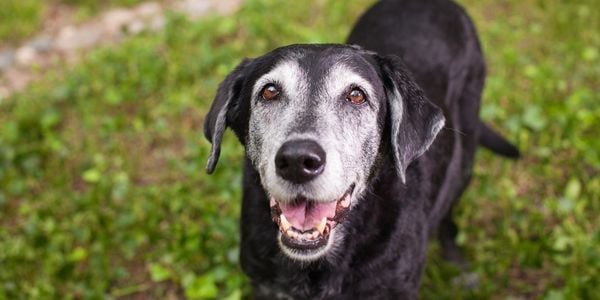
Does Your Dog Have LarPar?
You may be wondering if your sweet older pooch could possibly have laryngeal paralysis. It’s possible. So we’ll help you figure out the answer.
Signs and Symptoms of Laryngeal Paralysis
At the onset of laryngeal paralysis, the signs may be quite subtle and hard to tell. You may think some of the symptoms are because of your dog's older age and that they're slowing down a little. Things such as:
- Huffing more on walks
- Walking slower
- Sleeping more
- Coughing or gagging a little when drinking water or eating their food (every once in a while to start, then perhaps a little more frequently).
All of these symptoms are very non-specific and could easily be confused for old age, sore joints, etc. However, as LarPar progresses, these symptoms will too. Much of them are caused by lack of oxygen.
As symptoms get worse, your old pup may cough, gag or pant significantly when on walks or even stop to catch their breath multiple times. Their walks will be significantly shorter and slower as they just can’t keep up. They may even refuse to go on walks altogether (exercise intolerance). They will continue to take long naps. They will cough or gag almost all the time when drinking/eating. And as LarPar progresses, more specific symptoms will start to develop, such as:
- Change in bark (more hoarse sounding) — this is often the first sign most owners notice that something is different or wrong.
- Loud, raspy breathing noise, especially when breathing in. See the video example below.
- Syncope/Cyanosis — in severe cases, they may faint (experience a syncopal episode) due to a lack of oxygen, and their gums may turn blue (cyanosis)
These signs and symptoms can occur at any time but are typically worse in hot, humid weather, during exercise, during times of stress or excitement, or in particularly obese dogs.
Dogs that have experienced a syncopal episode (fainted) or who are cyanotic (gums are blue) require immediate emergency veterinary treatment as this is life-threatening.
Medical Problems Caused By LarPar
Additionally, secondary problems can occur as a result of LarPar, such as aspiration pneumonia, where food or water (or other foreign material) has been accidentally sucked into the lungs, causing a bacterial infection. This will need to be treated with antibiotics and can be very dangerous and result in hospitalization if not caught early and treated aggressively.
Furthermore, dogs with LarPar are vulnerable to heat stroke and heat exhaustion due to their limited ability to cool themselves down by panting (as they can’t get air in and out as effectively or efficiently). But this can and often is mistaken for simply heat stroke rather than heat stroke due to LarPar. If this happens, your dog must to be seen by a veterinarian immediately, as oxygen is what is going to save them.
Additionally, in unilateral cases (where only one side of the larynx is affected), the dog typically fares better than those in which both its arytenoid cartilages are not functioning (bilateral LarPar). The unaffected side compensates for the affected side for a period of time. However, most unilateral cases eventually progress to bilateral LarPar.
If your dog is exhibiting any of these signs or you are otherwise concerned that your dog might have laryngeal paralysis, don’t hesitate to speak with your veterinarian.
Diagnosis of Laryngeal Paralysis
Although the more specific symptoms of LarPar make it pretty clear that your dog has this condition, there is only one true way in which laryngeal paralysis can be definitively diagnosed.
Your veterinarian will directly examine the larynx under light with mild sedation. This way, the function of arytenoid cartilage can be evaluated as your dog breathes in and out voluntarily. If they aren’t opening and closing (like french doors) as they should, as your dog breathes in and out, or only one is, then the diagnosis is confirmed. The examination typically only takes a few minutes once they are sedated.
At the same time, this examination allows your veterinarian to check for tumors in the throat. Your vet may also recommend ruling out heart, lung, or mediastinal (the space in front of the heart) diseases or other possible causes of the symptoms often seen with LarPar. So, they'll suggest performing additional tests, such as thoracic radiographs (chest x-ray), a CT scan, or echocardiography (ultrasound of the heart).
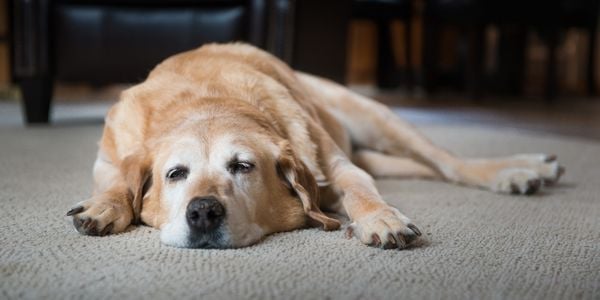
Treatment and Management of Laryngeal Paralysis
With mild cases of LarPar, it may be able to be managed by managing your dog's environment alone with occasional assistance from specific medications as needed.
Adjust Your Dog's Lifestyle and Weight
Start with limiting physical exercise, maintaining a healthy body weight, and avoiding high temperatures and stressful situations to control the need for panting, which causes unwanted respiratory distress.
Medications that may be dispensed for use when needed include mild sedatives for use to decrease anxiety and panting, which will improve respiration, and corticosteroids to be used in acute flare-ups to decrease any inflammation and edema (swelling) of the larynx that may have occurred if panting became out of control, and the throat became inflamed and swollen.
Additionally, most veterinarians recommend to no longer use a collar, including a flat or martingale collar, and absolutely no prong, choke, or electric collars. These put pressure on your dog's throat, increasing inflammation and swelling. Rather, your dog should be walked with the aid of a harness or even a head collar. Here's how to choose the right harness for your dog.
Laryngeal Surgery
In severe cases of LarPar, particularly when paralysis occurs in both arytenoid cartilages, surgery can be performed. This is known as arytenoid lateralization or laryngeal tieback surgery, where one of the arytenoid cartilages is sewn back in an abducted (open) position.
This reduces the symptoms associated with LarPar, such as inadequate ventilation and overheating. However, this surgery does not come without risks. It renders your dog unable to close that arytenoid cartilage (not that they were able to while it was paralyzed), which increases their risk of aspiration pneumonia. Hence, most veterinary surgeons recommend only tying back one arytenoid cartilage versus both, ideally decreasing this risk.
Upon recovery from this surgery, your dog will still sound hoarse and will need to be managed in the same way as those with mild cases of LarPar.
If you have any questions about this condition, leave a comment below.




